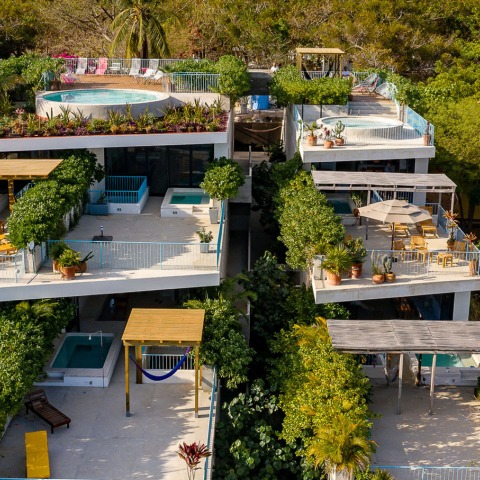The complex comprises of 16 residencies of 150 sqm plus the terrace, measuring 70 sqm on the lower level. The project has standard replicable pattern, enabling 180° views and plenty of natural light and ventilation in each unit.
Project description by Francisco Pardo Arquitecto
Nestled in the vegetation, the project respects the environment by mirroring the slope of the site with its 20° to 40° incline, through a sequence of stepping, rotation and intermediate patios. A standard replicable pattern is established, enabling 180° views and plenty of natural light and ventilation in each unit, thanks to a complex and alternating layout that offers residents a unique experience.
“This housing arrangement naturally adapts to the existing topography. The villas seek to generate a harmonic symbiosis between architecture, the Pacific Ocean and the inhabitants, enhanced by extraordinary panoramic views of the surroundings”.
Francisco Pardo, founder of the studio.
The complex comprises of 16 residencies of 150 sqm plus the terrace, measuring 70 sqm on the lower level. Despite the high-density on site, the apartments, embedded into the hillside in various ways, feel more like villas than apartments.
Each unit consists of two or three bedrooms, an open-plan living and dining room, and a private terrace – which frames the idyllic scenery and the sea-horizon, while guaranteeing maximum privacy through the extensive plants strategically placed around its perimeters.
Each apartment has a small private swimming pool, and three types of common areas feature on the uppermost rooftops: to the East (the highest), a bar and rest area; in the center, the main swimming pool with a sundeck; and to the West, a smaller pool for children.
The apartments are accessed through a system of natural pathways and two gardens that replicate the natural slope of the terrain and stretch down to the sea. The ocean breeze, in synergy with the shade provided by cantilevered roofs and the cross ventilation generated by the terrace and the lateral walls, provides passive cooling options.
Inside, the units offer a comfortable place to relax and take refuge from the sun. Natural-toned wood wraps the exquisitely tailored-made interiors, adding visual warmth and reinforcing the connection to the natural context.
Villas Escondida are entirely built with a simple structure of reinforced concrete, block walls, cement, sand and ribbed slabs. This system has permitted flexible construction and a solid structure, resistant to the characteristic earthquakes that affect the area. The main finishing details of the external facades and the interiors are made with Chukun, flattened with fine sand cement and the suggestive local “Macuil” wood.
Rather than trespassing on the landscape, this original project that slopes down toward the beach to catch the ocean’s breeze, is intended to integrate into the site blanketed with vegetation, emphasizing the architecture's connection to its natural setting.





















































